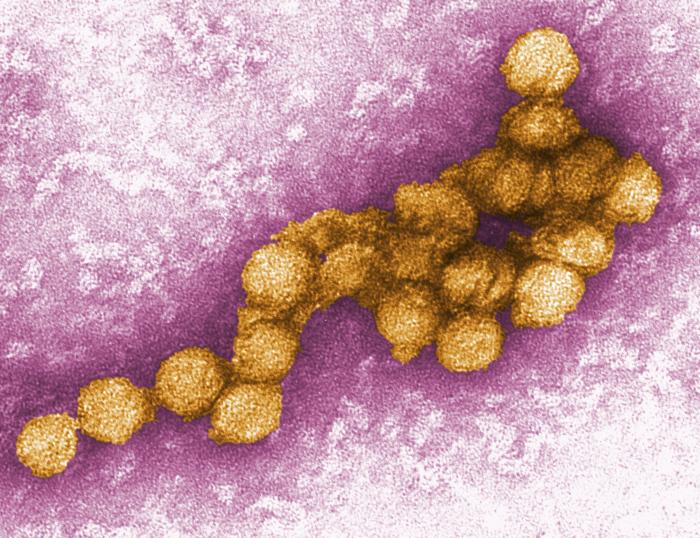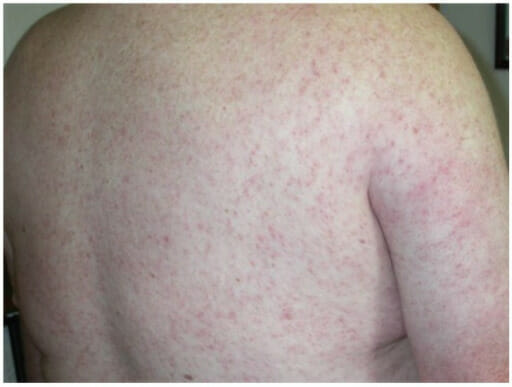West Nile virus Virus Viruses are infectious, obligate intracellular parasites composed of a nucleic acid core surrounded by a protein capsid. Viruses can be either naked (non-enveloped) or enveloped. The classification of viruses is complex and based on many factors, including type and structure of the nucleoid and capsid, the presence of an envelope, the replication cycle, and the host range. Virology is an enveloped, positive-sense, single-stranded RNA RNA A polynucleotide consisting essentially of chains with a repeating backbone of phosphate and ribose units to which nitrogenous bases are attached. RNA is unique among biological macromolecules in that it can encode genetic information, serve as an abundant structural component of cells, and also possesses catalytic activity. RNA Types and Structure virus Virus Viruses are infectious, obligate intracellular parasites composed of a nucleic acid core surrounded by a protein capsid. Viruses can be either naked (non-enveloped) or enveloped. The classification of viruses is complex and based on many factors, including type and structure of the nucleoid and capsid, the presence of an envelope, the replication cycle, and the host range. Virology of the genus Flavivirus Flavivirus A genus of flaviviridae containing several subgroups and many species. Most are arboviruses transmitted by mosquitoes or ticks. The type species is yellow fever virus. Tick-borne Encephalitis Virus. Birds are the primary hosts and the disease is most often transmitted by Culex mosquitoes. Most people infected with West Nile virus Virus Viruses are infectious, obligate intracellular parasites composed of a nucleic acid core surrounded by a protein capsid. Viruses can be either naked (non-enveloped) or enveloped. The classification of viruses is complex and based on many factors, including type and structure of the nucleoid and capsid, the presence of an envelope, the replication cycle, and the host range. Virology are asymptomatic. Some patients Patients Individuals participating in the health care system for the purpose of receiving therapeutic, diagnostic, or preventive procedures. Clinician–Patient Relationship develop West Nile fever Fever Fever is defined as a measured body temperature of at least 38°C (100.4°F). Fever is caused by circulating endogenous and/or exogenous pyrogens that increase levels of prostaglandin E2 in the hypothalamus. Fever is commonly associated with chills, rigors, sweating, and flushing of the skin. Fever (a self-limited, febrile illness) and a very small proportion of patients Patients Individuals participating in the health care system for the purpose of receiving therapeutic, diagnostic, or preventive procedures. Clinician–Patient Relationship develop West Nile neuroinvasive disease. West Nile neuroinvasive disease includes meningitis Meningitis Meningitis is inflammation of the meninges, the protective membranes of the brain, and spinal cord. The causes of meningitis are varied, with the most common being bacterial or viral infection. The classic presentation of meningitis is a triad of fever, altered mental status, and nuchal rigidity. Meningitis, encephalitis Encephalitis Encephalitis is inflammation of the brain parenchyma caused by an infection, usually viral. Encephalitis may present with mild symptoms such as headache, fever, fatigue, and muscle and joint pain or with severe symptoms such as seizures, altered consciousness, and paralysis. Encephalitis, and acute flaccid paralysis. The diagnosis is confirmed with serum serology Serology The study of serum, especially of antigen-antibody reactions in vitro. Yellow Fever Virus, CSF serology Serology The study of serum, especially of antigen-antibody reactions in vitro. Yellow Fever Virus, or PCR PCR Polymerase chain reaction (PCR) is a technique that amplifies DNA fragments exponentially for analysis. The process is highly specific, allowing for the targeting of specific genomic sequences, even with minuscule sample amounts. The PCR cycles multiple times through 3 phases: denaturation of the template DNA, annealing of a specific primer to the individual DNA strands, and synthesis/elongation of new DNA molecules. Polymerase Chain Reaction (PCR). Antiviral Antiviral Antivirals for Hepatitis B therapy is not available; therefore, management is supportive. Prevention is aimed at local mosquito control and donated blood and organ screening Screening Preoperative Care.
Last updated: Mar 28, 2025

RNA virus identification:
Viruses can be classified in many ways. Most viruses, however, will have a genome formed by either DNA or RNA. RNA genome viruses can be further characterized by either a single- or double-stranded RNA. “Enveloped” viruses are covered by a thin coat of cell membrane (usually taken from the host cell). If the coat is absent, the viruses are called “naked” viruses. Viruses with single-stranded genomes are “positive-sense” viruses if the genome is directly employed as messenger RNA (mRNA), which is translated into proteins. “Negative-sense,” single-stranded viruses employ RNA dependent RNA polymerase, a viral enzyme, to transcribe their genome into messenger RNA.

A colorized transmission electron microscopic (TEM) image of West Nile virions
Image: “West Nile virus” by CDC/P.E. Rollin. License: Public DomainTwo phylogenetic lineages of West Nile virus Virus Viruses are infectious, obligate intracellular parasites composed of a nucleic acid core surrounded by a protein capsid. Viruses can be either naked (non-enveloped) or enveloped. The classification of viruses is complex and based on many factors, including type and structure of the nucleoid and capsid, the presence of an envelope, the replication cycle, and the host range. Virology cause the following diseases:

A female Culex mosquito responsible for transmission of West Nile virus
Image: “Culex mosquito” by CDC/James Gathany. License: Public DomainHigher risk for infection:
Higher risk for neuroinvasive disease:
The majority of patients Patients Individuals participating in the health care system for the purpose of receiving therapeutic, diagnostic, or preventive procedures. Clinician–Patient Relationship are asymptomatic. Symptomatic disease can vary in severity and presentation.
Approximately 20% of infected patients Patients Individuals participating in the health care system for the purpose of receiving therapeutic, diagnostic, or preventive procedures. Clinician–Patient Relationship will develop a mild, self-limited disease.

Maculopapular rash due to west nile virus
Image: “Diffuse maculopapular rash associated with West Nile virus infection” by James J Sevjar. License: CC BY 3.0Approximately 1% of infected patients Patients Individuals participating in the health care system for the purpose of receiving therapeutic, diagnostic, or preventive procedures. Clinician–Patient Relationship may experience:
Definitive studies:
Supporting evaluation:
No antiviral Antiviral Antivirals for Hepatitis B therapy is currently available; management is supportive. In patients Patients Individuals participating in the health care system for the purpose of receiving therapeutic, diagnostic, or preventive procedures. Clinician–Patient Relationship with neuroinvasive disease, the following may be needed:
| Organism | Tick-borne encephalitis Tick-borne encephalitis Encephalitis caused by neurotropic viruses that are transmitted via the bite of ticks. In europe, the diseases are caused by encephalitis viruses, tick-borne, which give rise to russian spring-summer encephalitis, central european encephalitis, louping ill encephalitis, and related disorders. Powassan encephalitis occurs in north america and russia and is caused by the powassan virus. Aseptic meningitis and rarely encephalitis may complicate colorado tick fever which is endemic to mountainous regions of the Western United States. Tick-borne Encephalitis Virus virus Virus Viruses are infectious, obligate intracellular parasites composed of a nucleic acid core surrounded by a protein capsid. Viruses can be either naked (non-enveloped) or enveloped. The classification of viruses is complex and based on many factors, including type and structure of the nucleoid and capsid, the presence of an envelope, the replication cycle, and the host range. Virology | Japanese encephalitis virus Japanese encephalitis virus A species of flavivirus, one of the japanese encephalitis virus group, which is the etiological agent of japanese encephalitis found in Asia, southeast Asia, and the Indian subcontinent. Encephalitis | St. Louis encephalitis Encephalitis Encephalitis is inflammation of the brain parenchyma caused by an infection, usually viral. Encephalitis may present with mild symptoms such as headache, fever, fatigue, and muscle and joint pain or with severe symptoms such as seizures, altered consciousness, and paralysis. Encephalitis virus Virus Viruses are infectious, obligate intracellular parasites composed of a nucleic acid core surrounded by a protein capsid. Viruses can be either naked (non-enveloped) or enveloped. The classification of viruses is complex and based on many factors, including type and structure of the nucleoid and capsid, the presence of an envelope, the replication cycle, and the host range. Virology | West Nile virus Virus Viruses are infectious, obligate intracellular parasites composed of a nucleic acid core surrounded by a protein capsid. Viruses can be either naked (non-enveloped) or enveloped. The classification of viruses is complex and based on many factors, including type and structure of the nucleoid and capsid, the presence of an envelope, the replication cycle, and the host range. Virology |
|---|---|---|---|---|
| Characteristics | The structural features are almost identical. | |||
| Region |
|
|
North America |
|
| Transmission | Tick | Mosquito | Mosquito | Mosquito |
| Clinical |
|
|
|
|
| Diagnosis |
|
Serology Serology The study of serum, especially of antigen-antibody reactions in vitro. Yellow Fever Virus | Serology Serology The study of serum, especially of antigen-antibody reactions in vitro. Yellow Fever Virus |
|
| Management | Supportive | Supportive | Supportive | Supportive |
| Prevention |
|
|
Mosquito avoidance measures | Mosquito avoidance measures |